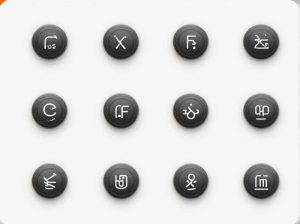Prussian Blue is a deep blue pigment with a rich history in art medicine and industry. It is known for its intense color chemical stability and wide range of applications. But what exactly is its chemical formula?
The formula of Prussian Blue is:
This complex compound consists of iron (Fe) and cyanide (CN) groups forming a unique crystal lattice structure. In this topic we will explore the composition properties and uses of Prussian Blue in detail.
The Chemical Formula of Prussian Blue
The molecular formula of Prussian Blue is:
✔ Fe₄[Fe(CN)₆]₃ represents the iron-cyanide complex that gives Prussian Blue its unique properties.
✔ xH₂O indicates the presence of water molecules in the structure which can vary depending on its form.
This formula shows that Prussian Blue is a coordination compound meaning it consists of metal ions linked by ligands (cyanide groups).
How Is Prussian Blue Formed?
Prussian Blue is created through a chemical reaction between iron(III) salts and hexacyanoferrate(II) compounds.
Reaction Formula
✔ Iron(III) ions (Fe³⁺) react with hexacyanoferrate(II) ([Fe(CN)₆]⁴⁻).
✔ The result is insoluble Prussian Blue which forms a deep blue precipitate.
This reaction is responsible for the formation of the pigment used in paints dyes and medicine.
Physical and Chemical Properties of Prussian Blue
Prussian Blue has unique physical and chemical characteristics that make it useful in various fields.
1. Physical Properties
✔ Color: Intense deep blue
✔ Solubility: Insoluble in water and most solvents
✔ Structure: Crystalline solid
✔ Stability: Resistant to heat and light
2. Chemical Properties
✔ Oxidation States: Contains both Fe²⁺ and Fe³⁺ ions.
✔ Magnetism: Shows ferromagnetic behavior at low temperatures.
✔ Ion Exchange Ability: Can trap certain toxic metal ions making it useful for detoxification.
Applications of Prussian Blue
Prussian Blue is widely used in art medicine chemistry and industry due to its unique properties.
1. Prussian Blue in Art and Pigments
Prussian Blue was one of the first synthetic pigments and remains popular in painting and printing.
✔ Used in oil paints watercolors and fabric dyes.
✔ Was famously used by Hokusai in his artwork “The Great Wave off Kanagawa”.
✔ Provides a vibrant blue shade that does not fade easily.
2. Prussian Blue in Medicine
Prussian Blue is an FDA-approved antidote for treating heavy metal poisoning.
✔ Used to remove radioactive cesium (Cs-137) and thallium (Tl) from the body.
✔ Works by binding to metal ions in the intestines preventing absorption.
✔ Safe for oral use but should be taken under medical supervision.
3. Prussian Blue in Chemistry and Science
Prussian Blue is used in scientific research and chemical tests.
✔ Helps in detecting iron in chemical analysis.
✔ Used in electrochemical studies due to its redox properties.
✔ Forms the basis of Prussian Blue analogs (PBAs) used in batteries.
4. Prussian Blue in Industry
Prussian Blue is also valuable in industrial applications.
✔ Used in blueprints and photographic printing.
✔ Applied in coatings and plastics for color enhancement.
✔ Used in the production of nanomaterials and biosensors.
How Does Prussian Blue Work as an Antidote?
One of the most important uses of Prussian Blue is in radiation emergency treatment.
✔ Binds radioactive cesium (Cs-137) and thallium (Tl) in the intestines.
✔ Prevents reabsorption allowing safe elimination through feces.
✔ Reduces the biological half-life of these toxic metals in the body.
This property makes Prussian Blue life-saving in nuclear accidents and poisonings.
Comparison of Prussian Blue with Other Blue Pigments
| Pigment Name | Chemical Formula | Color Stability | Uses |
|---|---|---|---|
| Prussian Blue | Fe₄[Fe(CN)₆]₃ | High | Paints medicine industry |
| Cobalt Blue | CoAl₂O₄ | Very High | Ceramics glass paint |
| Ultramarine | Na₈-10Al₆Si₆O₂₄S₂-4 | High | Art cosmetics plastics |
✔ Prussian Blue is cheaper than cobalt blue and ultramarine.
✔ It has better toxicity removal properties unlike other pigments.
Is Prussian Blue Toxic?
Despite containing cyanide Prussian Blue is non-toxic because the cyanide groups are tightly bound to iron.
✔ Does not release cyanide under normal conditions.
✔ Safe for use in medicine and pigments.
✔ Considered environmentally friendly compared to synthetic dyes.
The History of Prussian Blue
Prussian Blue was accidentally discovered in 1704 by Johann Jacob Diesbach a Berlin-based chemist.
✔ Originally meant to make red dye but turned blue due to iron contamination.
✔ Became widely used in art and textile dyeing.
✔ Inspired synthetic pigment development revolutionizing color chemistry.
Future Applications of Prussian Blue
Scientists are exploring new uses of Prussian Blue in advanced technology.
✔ Battery Development: Used in sodium-ion batteries for energy storage.
✔ Water Purification: Helps remove heavy metals and pollutants.
✔ Medical Imaging: Potential use in MRI contrast agents.
Prussian Blue with the formula Fe₄[Fe(CN)₆]₃ is a versatile compound used in art medicine chemistry and industry. Its deep blue color non-toxicity and ability to bind metals make it valuable in scientific and practical applications. From historical paintings to modern radiation treatment Prussian Blue remains an essential and fascinating chemical compound.



